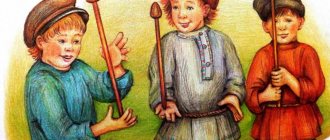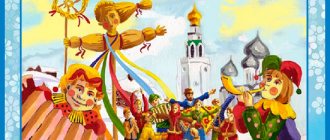Scientists say that creative thinking helps humanity solve many problems and achieve great achievements. You need to learn to think creatively from an early age, and interesting games that will captivate not only children, but also parents will help with this.
The importance of creativity games for children
Stanford University professor Dan Kline says that every person has a large reserve of creativity that will help find a suitable solution in any situation. You can imagine the reserve of creativity in the form of a treasure chest. When a problem arises, an idea is taken from the treasured chest and brought to life. Unfortunately, many people, for some reason, open the chest and take advantage of its contents.
And when it is necessary to make a non-standard decision, a person uses proven methods and does not approach the situation creatively. To overcome the fear of something new and original, you need to develop creative thinking from childhood. And exciting games can help with this.
How the game can help:
- development of hidden abilities;
- the ability to draw conclusions from one’s mistakes;
- lifting your spirits;
- creating a fun, relaxed environment;
- development of imagination and creative potential.
Content:
- Children's games at home
- Entertaining games for children at home: types
- Active games
- Sport games
- Competitions
- Games for development
- Speech games
- Construction of houses
- Math games
- Interesting games for two children
- Role-playing games
- Unusual home games
- Music games
- Water games
- Interesting games
- Recommendations for parents
Game "Celebrating Mistakes"
The ability to improvise helps a person both in non-standard situations and in everyday life. Since improvisation requires courage, the exercise should be carried out in trusted company, where no one will ridicule or speak negatively. So, we learn to “celebrate mistakes.” You need to perceive mistakes as a gift that helps you draw conclusions. But every time we are afraid of making mistakes, we act too cautiously, and this prevents us from thinking creatively.
The point of the game is as follows. Participants sit in a circle, and each player in turn says: “I made a mistake,” “I was wrong,” “I did everything wrong,” etc. Let adults observe the facial expressions with which children pronounce such phrases. Surely, at the same time, the child shrinks, as if he wants to become invisible in order to avoid punishment for a mistake. People are afraid of criticism, they are afraid of a negative reaction from others. Now invite the players to say the same phrases with joy, as if they want to celebrate a great event.
Competitions
Sedentary children's games will also help you out in a situation where children need to be occupied with something, especially since space or time may not allow active movement. Such an activity requires, albeit minimal, preparation. And, as you know, it can be no less interesting than the process of the game itself.
Quiz
Invite your child to become the host and prepare a competition, say, for a family dinner or tea party, when the whole family gathers at the table.
Tell me what questions or riddles to choose, prepare prizes for correct answers, choose a winner, break up the scenario with a musical break, turning on karaoke or dance music.
Over time, such quizzes can become thematic and turn into a good family tradition.
Suitable for ages: 7-13 years old.
Reply in a minute
Prepare a list of simple questions and organize joint games for children at home if you have two or more. Offer to try to give as many correct answers to the questions as possible in a minute.
Thus, you will train your quick thinking and reaction speed. Select questions from the area of general knowledge or on topics that children know well, as well as in accordance with age.
Suitable for age: 7-15 years old.
Game "False Memories"
Often creative ideas from partners help achieve incredible success. Work is based on the principle of joint cooperation, and it is very important to hear your partner and accept even a seemingly crazy idea.
The game "False Memories" is the following. Two participants pretend that they have known each other all their lives, they have common affairs and interests. The first participant says: “Remember, you and I...”. Then you can fantasize, for example:
- flew into space;
- went on a trip around the world;
- got into a cartoon;
- explored the depths of the sea;
- found a time machine, etc.
You don’t have to come up with implausible fantasies; you can also make up some realistic story.
1st participant:
“Do you remember when we climbed into our neighbor’s garden and wanted to steal apples? And then they ran away because a neighbor noticed us?”
The second player must refute what the first player said.
2nd participant:
“No, it wasn't like that at all. A dog chased us, but the neighbor managed to lock it in the enclosure, and then invited us to visit.”
The story continues, and the participants offer their options for the development of non-existent events. Thus, players learn to refute their opponent's words, but do it creatively, offering their own version. The game turns out to be fun, interesting and not boring.
Exercises
Developing creative thinking is a fun and easy process. The main obstacle you will face is your inner critic. Some exercises will seem stupid, pointless, stupid to you. Feel free to brush aside all these thoughts. Allow yourself, at least for the duration of your training, to be frivolous and fool around from the heart.
The tasks presented are suitable for adults and teenagers. Remember that they don't have the right solutions. Therefore, the question of whether I do everything this way should not bother you.
I accompanied some exercises with comments and shared my options for performing them. I encourage you to share too. There is a comment field at the bottom of the article. You can send the results of your creative activities there.
Associations
Pick up a book, open it to a random page and point your finger at any word without looking. Now come up with as many associations to it as possible. Start with the most obvious ones, and then try to get as far away from them as possible. At the end of the list you will have associations that only you understand. And that's okay.
I came across the word “notebook”. My associative row with him looks like this: words, sheets, paper, lines, white, diary, essay, numbers, mathematics, four, rustling, stain, crumbs, pocket, wound.
Paradoxical connections
Choose two words that are not related to each other. You can use the book again. Now try to come up with a sentence that uses both words logically.
I came across the words “monkey” and “win”. This is what I did with them: “I spent the whole evening trying to beat the monkey at chess, but I couldn’t.”
Instructions
Take any item and try to come up with as many ways to use it as possible. The more unusual and interesting they are, the better.
I took a toothbrush. She can:
- brush your teeth;
- clean shoes;
- paint;
- comb hair;
- apply a face mask;
- comb out cat hair;
- scratch your back, etc.
Once you have your list ready, come up with instructions for one of the uses. It might look something like this:
Take the toothbrush, place it in your right hand and clasp it tightly with all five fingers. Place your hand behind your back and begin to move up and down your back in the place where the itching is felt. Continue until the itching goes away. Perform multiple approaches if necessary.
Limited story
The essence of the exercise is that you need to come up with a story consisting of a certain number of words. You set this quantity in advance. For example, 100 words, 50 or 200. Try different options.
You cannot deviate even a word from the given quantity! The story should be coherent and logical. It must contain all the necessary elements of a story: beginning, climax and denouement.
New language
As a child, I loved inventing new letters and words. As it turns out, this is a great exercise in creativity. Try creating your own language. Start by writing the alphabet, then move on to words and sentences.
John Tolkien, author of the Lord of the Rings trilogy, had a lot of fun doing this exercise. As a result, he created the Elvish language, which is still spoken by admirers of his work.
Biography
Next time you find yourself in a crowded place, people watch. On public transport or in a queue, choose one “victim” for yourself and try to compile her biography. What kind of person is this, who does he work for, what is his hobby, what skeletons does he keep in his closet.
Idea's generator
Your task is to come up with as many ideas as possible of what to do on vacation. Let it be 100. Imagine that your boss was generous and gave you a whole year to rest. What will you do all this time?
Pros and cons
Take some thought, idea or statement and have a debate of sorts. First, formulate all the arguments in favor. Then take the other side and come up with arguments against it.
The statement may be completely meaningless and paradoxical. For example: “Blue whales can fly.” Accordingly, the arguments may seem stupid, far-fetched, and childish. Ignore these thoughts. One of the main goals of developing creativity is to defeat the inner critic. It is he who places severe restrictions on our way of thinking.
Essays
Mentally go back to school and remember your literature lessons. Just don’t rush to throw a slipper at me for such advice! I won’t force you to write down the meaning of Tatiana’s letter to Eugene Onegin on four sheets of paper. You can take absolutely any topic for your essays. The main thing is that you can reason and get smart enough.
Here is a list of ready-made topics if your imagination fails you:
- Why is the cold side of the pillow more pleasant than the warm side?
- What is the meaning of the expression “Called yourself a load, get into the back.”
- The moral background of Olga Buzova’s song “Halves Are Few.”
- Why a Bulgarian is a resident of Bulgaria, and a Bulgarian is an instrument.
Screenwriter
Start watching a movie you haven't seen before. When you reach the middle, pause the recording and try to predict the development of the plot. Think about what will happen to the key characters, what the ending of the story will be. It is best to do this in writing and then compare it with the original.
Fairytale creatures
What happens if you attach wings to a hedgehog? How about adding a trunk to the rhinoceros? Think of some strange non-existent animals and think about how they would live in the wild. For greater effect, you can draw them on paper or create them in a graphics editor. This will be excellent training for creative thinking.
Letter benefit
Your task is to come up with a sentence in which all words begin with the same letter. The longer it gets, the better. Try to make it meaningful, but don’t pick too much on the meaning.
This is what I came up with: “A cheerful crow cooed in Voronezh, spinning like a top in spite of everything.”
Finishing drawing
This is a team exercise. You can do it in the company of friends. One person must draw some detail on a piece of paper: a line, a stroke, a figure, a squiggle. The next one continues to draw something of his own on the same sheet, followed by another one. And so on.
Dictionary
One of my favorite exercises. You need to come up with new words based on existing ones. And do it in such a way that their meaning can be understood. Let me give you a few examples:
- Self-praise is a person who praises himself.
- Late market is a store that is open at night.
- Beecat is a cat with black and yellow stripes.
- Offended - a toad who is offended all the time.
- Tramvasya – Vasya, who loves to ride the tram.
Multiple solutions
This exercise not only develops creative thinking, but also helps to find the best way out of difficult situations. Next time you're faced with a real problem, brainstorm. Sit down and come up with as many possible solutions as possible.
Write down even the most ridiculous and crazy ideas. Perhaps one of them will be able to bypass the very stumbling block that you have been fighting against for more than one day.
I recently read a funny story on the Internet. The guy couldn't get his dorm roommate to clean up the mess. Then he registered on a dating site on behalf of the girl and met this slob there. The virtual romance developed rapidly, and soon the neighbor invited a new acquaintance to visit. Having received consent, he began to clean up. Soon the room was sparkling clean. Here is such a non-standard and creative way to solve the problem.
Abbreviations
Write a few short words of 3-5 letters. Then come up with a decoding for each word, as if it were an abbreviation.
For example:
- MOUTH – Fish Omelet with Cumin;
- MOUNTAIN – Sad Ombudsman Working as an Auto Mechanic;
- NIK – Scientific Research Sausage;
- LEV – Best European Currency.
The funnier, more surprising, and more paradoxical the acronyms are, the better.
Backwards
When walking down the street, read the words on signs and advertising banners backwards. For example, not a store, but “nizagam”, not a stop, but “akvonatso”. When you get used to words, you can take on phrases and sentences.
Illogical reading
Try reading fiction in an unusual way. Start not from the beginning, but from the middle. Anything that is not clear, figure it out yourself as the story progresses.
Take a look at our selection of books about thinking.
Idioms
The Russian language is rich in popular expressions, sayings, colorful epithets, and idioms. Some of them are well-known, but not all philologists know about the existence of some. I suggest you think about it and try to come up with an explanation for not the most famous Russian sayings. And then google the real meaning and evaluate the work of your imagination.
So, let's go:
- The birch is white, but the tar is black.
- One son is not a son, two sons are half a son, three sons are a son.
- The king favors, but the huntsman does not favor.
- It is high to God, far from the king.
What's in the picture
Type the phrase “incomprehensible photos” into your search engine and enjoy the fruits of human madness. Choose a couple of the strangest images and try to explain what is happening in them. It is desirable that the explanation be as crazy as the picture itself.
I really liked this photo, you can start with it.
Cut fragment
This exercise will help stimulate your brain and wean it from thinking in patterns. Find a reproduction of a well-known painting on the Internet, print it out and cut out the image of the key character with scissors. Yes, even the same Mona Lisa.
Think about what kind of environment Leonardo da Vinci's muse could organically fit into. You can, for example, imagine her sitting in a hairdresser's chair. Or imagine yourself in the role of a psychotherapist who listens to the client’s complaints. There are a lot of options. The most gifted ones can try to draw this setting on a piece of paper, and place a cut out character in the center.
Rewind
Learn to think in the opposite direction, namely: to build a logical chain not from beginning to end, but from end to beginning. If you know how to play chess, you can use this skill. Arrange the pieces on the board randomly and try to imagine what moves could lead to such an arrangement.
Fluke
Every time you are faced with some problem, resort to the help of words. Take any book, point at the first word you come across and try to find the key to the solution in it.
It’s not a fact that you will succeed, but it’s not that important. The main goal of the exercise is to shift your thoughts from the well-worn template rails towards creative thinking.
More than 100 cool lessons, tests and exercises for brain development
Start developing
Rearrangement
For this exercise we'll need a couple of news headlines. You can look for them in newspapers or on online news portals. When you find a worthwhile option, swap the nouns in it. For example, it was: “Golikova reported an increase in mortality in Russia,” but it became: “Mortality reported an increase in Golikova in Russia.” Or it was: “Scientists have invented a cure for coronavirus,” but it became: “Coronavirus has invented a cure from scientists.”
The resulting version will seem nonsense to you. Your mission is to fill it with as much meaning as possible. For example, the coronavirus has mutated into intelligent activity and figured out how to exterminate the scientists fighting it (ugh, ugh, I’ll go knock on wood).
Eternal questions
Remember yourself as a child. With the help of endless questions addressed to adults, you tried to get to the bottom of things and processes.
– Why does the tree sway?
- Because the wind blows.
– Why does the wind blow?
– Because the temperature changes.
– Why does the temperature change?
- Leave me alone, I'm tired of you with your questions!
Today, you are an adult, which means you can ask questions to yourself. Every time a question pops up in your mind, don't limit yourself to it. Build the chain further. After 3-4 questions you realize how little you actually know. A great reason to start expanding your horizons.
Double Look
Surely you have come across pictures in which you can see two different images by changing the focus of attention. Your task is to draw a similar picture. The excuse “I can’t draw” is not accepted. Take something simple, at least a vase and two faces. When you draw, you use the right hemisphere of your brain. As you know, it is precisely this that is responsible for creativity.
Drawing with both hands
Another exercise to develop the right hemisphere and improve interhemispheric impulse transmission. Take a pen or pencil in each hand. Start drawing a circle with one hand and a triangle with the other. This must be done simultaneously.
At first you will not be able to draw either of the two figures properly. Practice until you can make independent movements with both hands.
Abstract paintings
Ever taken a Rorschach personality test? Test subjects are required to look at abstract inkblots and choose what they look like. You and I will do something similar.
Take a sheet of paper and paint. After thoroughly wetting the brush, leave a few tasty blots on the sheet. You can use several colors. Then fold the sheet in half so that the stains are printed symmetrically on both sides of the sheet. You should end up with something similar.
I advise you to make several different copies at once. And then sit down to decipher it.
Look at each image in turn. What do you see on them? Try to come up with several options at once. The more complex they are, the better. For example, not a butterfly, but two bears climbing a palm tree with umbrellas in their teeth.
Defocus
Creative thinking does not tolerate rigidity and tension. The brain must be in a light and semi-relaxed state to think in new ways. Now we will learn to create such a state.
Start to perceive signals from all senses at once. Listen to the sounds outside the window, inhale the smell coming from the kitchen, look around, feel the touch of a warm blanket on your feet. At this moment, the brain will come into a defocused state and seem to freeze. Try to maintain this state for at least a few minutes. Increase the time each time.
Weird art
This exercise will help you not only develop creative thinking, but also get acquainted with the world's masterpieces of painting. History knows many artists who created paintings that were far from artistic realism. The most popular is Salvador Dali. Besides him there is Rene Magritte, Wassily Kandinsky, Max Ernst, Joan Miró and many others.
Start getting acquainted with the work of one of them. Carefully examine the paintings, look for an explanation for what you saw, reflect on the meaning that the author wanted to convey. This will help expand the boundaries of consciousness and learn to look at things from different angles.
My favorite is the late 15th century Dutch artist Hieronymus Bosch. His paintings contain many details, symbols, and encrypted messages. You can look at them for hours.
Getting to know the problem
The next time you encounter a problem, try to get to know it better. Ask yourself the following questions:
- What would problem taste like if it could be eaten?
- If she were a living creature, what kind would she be? Give reasons for your answer.
- If problem could talk, what would it tell you?
- Does the problem have siblings? What is her outlook on life? What does she do in her free time?
Reification of abstract concepts
We use many words in speech that have no material expression. These are abstract concepts and categories that exist only in our minds, for example: inspiration, mentality, spirituality, proof, confusion, etc. You can continue this series yourself.
Try to draw these words on a piece of paper. What do you associate them with? What do they look like? It will be great if you approach this exercise with all your imagination and create colorful detailed images.
By the way, you can train creative thinking online using special applications. On our website we have an overview of the most effective ones.
Game "I agree"
A variation of the previous game, only here the participant, on the contrary, agrees with everything that the second player comes up with. In this exercise, it is important to show your opponent from the positive side, to highlight his best qualities. We must remember that improvisation is not a field for ridicule and cruel jokes.
1st participant: Do you remember how we went to the ocean?
Participant 2: Yes, the weather was beautiful!
1st participant: And watched the crabs?
2nd participant: You were still fishing!
1st participant: And you brought me delicious lemonade!
The game reveals creative potential and teaches you to instantly use your imagination. A person can think critically, but for creative development it is also important to improvise, think positively, and not evaluate the actions of people around him.
Game “Distract the Inner Monster”
A terrible dragon lives inside every person, that is, fear, which is usually very difficult to cope with. Acclaimed director Keith Johnstone offers this game to harness your inner dragon.
In one minute (it’s better to set a timer on your phone), write a short story on a piece of paper. It is important to invest in the set time, but to make it easier for players, you can offer the first phrase with which the story will begin. Players turn on their imagination and come up with the most incredible stories, while not using their inner critic, but revealing their creative potential.
Both bad and good
Typically, children evaluate what is happening in two categories - “good” and “bad”. Invite him to evaluate unpleasant situations in life using these categories, let him find the positive in the situation. They lost a backpack with toys - now he has become more attentive and the parents will buy a new beautiful backpack. We were sick at home for a week, but we trained our immunity and also read four thick books. We arrived at the seaside, and it was raining there - we went to the cinema, rode horses.
We, adult optimists, are accustomed to seeing positive moments, but children should be trained in this.
Game "Associations"
The player needs to look around and select any object that comes into view. For example, a person noticed a flowerpot with a flower. Then you need to write down on paper 6-7 adjectives that fit this subject, for example:
- Beautiful;
- beige;
- unusual;
- bright;
- clay;
- fragile;
- stylish.
After this, you need to write 6-7 more adjectives that are not at all suitable for the chosen subject. For example, a flowerpot cannot be:
- fried;
- wrinkly;
- salty;
- funny;
- sad;
- silk;
- poor.
Fantasy lives in every person, but you need to be able to use your creative potential. The more creativity is developed, the more unusual, interesting ideas can be used in a variety of life situations.
leave a comment










